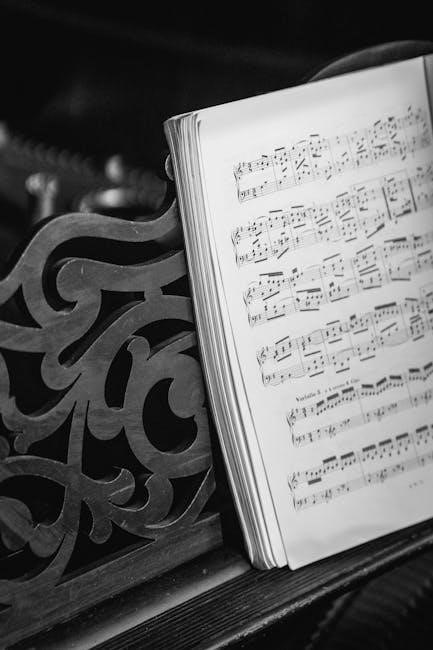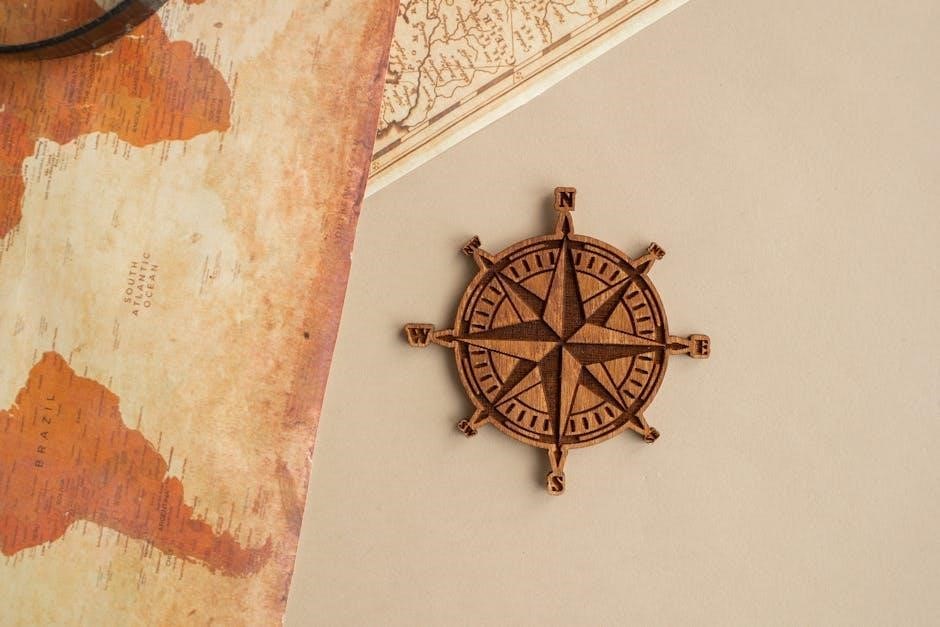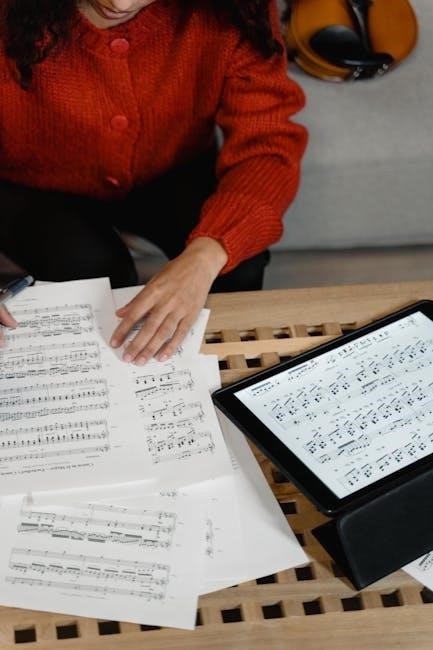An instrument study guide is a structured resource designed to enhance learning, helping identify weaknesses and guide practice effectively. It provides essential tools for mastering your instrument, ensuring progress and achieving musical goals.
1.1 What is an Instrument Study Guide?
An instrument study guide is a structured resource designed to aid musicians in mastering their instrument. It provides detailed lessons, exercises, and practice strategies tailored to various skill levels. These guides often include theory, technique-building activities, and performance tips. They help identify weaknesses, enhance practice sessions, and track progress. Whether for beginners or advanced players, these guides offer a comprehensive approach to learning, ensuring steady progress and helping achieve musical goals effectively.
1.2 Importance of Using a Study Guide for Instrument Learning
An instrument study guide is essential for effective learning, offering a structured approach that caters to all skill levels. It provides a clear roadmap for progress, helping musicians identify weaknesses and track improvements. With organized lessons and resources, study guides ensure focused practice, saving time and enhancing the learning experience. They keep learners motivated, enabling steady skill development and a deeper understanding of their instrument.

Choosing the Right Instrument
Selecting the right instrument is crucial for effective learning and enjoyment. Consider your musical interests, skill level, and goals to find an instrument that aligns with your aspirations.
2.1 Factors to Consider When Selecting an Instrument
When choosing an instrument, consider your musical interests, skill level, and goals. Think about the type of music you want to play, as some instruments suit specific genres better. Assess your budget, as costs vary widely. Portability and maintenance requirements are also important. Personal preference and physical comfort play a role, ensuring you enjoy playing. Lastly, consider available resources and support, such as teachers or online tutorials, to aid your learning journey effectively.
2.2 Popular Instruments for Beginners
Popular instruments for beginners include the guitar, piano, flute, violin, and ukulele. These instruments are great for starting your musical journey due to their accessibility and forgiving nature. The ukulele, with its soft strings and fewer frets, is ideal for those with smaller hands. The recorder is also a common choice in schools for its simplicity. Drums, while physically demanding, offer a fun and engaging way to develop rhythm. Each instrument has unique benefits, making it easier to find one that suits your interests and learning style.
2.3 Where to Find the Best Instruments for Study
Beginners can find high-quality instruments for study through online marketplaces, local music stores, or rental services. Websites like Musician’s Friend and Guitar Center offer a wide selection. Local music shops provide personalized advice and instrument trials. Rentals are ideal for those unsure about long-term commitment. Additionally, online forums and communities often recommend trusted brands and retailers. Ensure the instrument aligns with your goals and budget for an optimal learning experience.

Setting Goals and Expectations
Setting clear, measurable goals helps guide your instrument study, ensuring alignment with your motivation and time commitment. Define objectives, understand the required dedication, and maintain realistic expectations to stay motivated and track progress effectively.
3.1 Defining Your Musical Goals
Defining your musical goals is crucial for effective learning. Consider the type of music you want to play, your practice schedule, and the level of proficiency you aim to achieve. Setting specific, measurable objectives helps maintain focus and motivation. Whether you aspire to play for enjoyment or pursue professional opportunities, clear goals guide your progress and ensure steady improvement in your instrument study journey.
3.2 Understanding the Time Commitment Required
Mastering an instrument demands consistent practice, requiring a significant time investment. Even short daily sessions can lead to progress, but advancing to higher levels necessitates more dedication; Assess your lifestyle to determine how much time you can realistically allocate without causing burnout. Setting a balanced schedule ensures steady improvement while maintaining enjoyment. Tracking progress helps stay motivated, even when challenges arise during your instrument study journey.
3.3 Setting Realistic Expectations for Progress
Setting realistic expectations is crucial for a positive instrument study experience. Progress varies among individuals, depending on dedication, natural ability, and practice quality. Celebrate small milestones to stay motivated, as mastery takes time. Understand that consistent effort yields gradual improvement, aligning with your goals. Patience and persistence are key; avoid comparing your journey to others. Focus on enjoying the process and embracing the challenges that contribute to growth and lifelong learning in your instrument study.

Understanding the Basics of Your Instrument
Mastering your instrument begins with understanding its components, proper care, and essential accessories. This foundation ensures effective learning and prolongs the instrument’s longevity for years of enjoyment.
4.1 Parts and Components of Your Instrument
Understanding your instrument’s parts is crucial for effective play and maintenance. For string instruments like guitars or violins, familiarize yourself with strings, frets, tuning pegs, and bows. Woodwind instruments like flutes have keys, pads, and embouchure holes. Brass instruments include valves, mouthpieces, and slides. Keyboards and pianos feature keys, hammers, and pedals. Properly caring for these components ensures optimal sound quality and longevity. Regular cleaning, storing in a dry place, and avoiding extreme temperatures are essential maintenance practices to preserve your instrument’s performance and lifespan over time.
4.2 Basic Maintenance and Care Tips
Proper maintenance ensures your instrument’s longevity and optimal performance. Regularly clean surfaces with a soft cloth and avoid extreme temperatures or humidity. For string instruments, change strings as needed and store them in hard cases. Woodwinds require swabbing the interior after use, while brass instruments should have valves and slides lubricated. Pianos need keys cleaned gently and hammers dusted. Always handle your instrument with care, avoiding drops or bumps. Schedule professional tunings or adjustments periodically to maintain sound quality and playability.
4.3 Essential Accessories for Instrument Study
Essential accessories enhance your learning experience and instrument care. A music stand holds your sheet music at eye level, while a metronome helps improve timing. Tuners ensure accurate pitch, and cases protect your instrument during transport. Cleaning cloths prevent dust buildup, and extra strings or reeds are vital for string and woodwind players. Rosin for bow instruments and a mute for brass are also key. Invest in quality accessories to support your practice and maintain your instrument’s condition for optimal performance and longevity.

Practice Strategies for Effective Learning
Effective practice involves setting goals, tracking progress, and using tools like metronomes. Stay motivated by celebrating small achievements and maintaining a consistent, focused practice routine daily.
5.1 Creating a Daily Practice Schedule
A well-structured daily practice schedule is crucial for consistent progress. Allocate specific time slots for warm-ups, technique exercises, and repertoire practice. Start with short, manageable sessions and gradually increase duration as you build stamina. Set clear goals for each practice session to maintain focus. Incorporate tools like metronomes to improve timing and record yourself to track improvement. End each session with a cool-down to prevent fatigue. Consistency is key, so prioritize regular practice over occasional long sessions. Celebrate small milestones to stay motivated and engaged.
5.2 Effective Techniques for Practicing Scales and Arpeggios
Mastering scales and arpeggios requires focused practice. Begin with slow tempos, ensuring accuracy, and gradually increase speed. Break scales into smaller sections to build muscle memory. Use a metronome to improve timing and rhythm. Practice scales in different keys to enhance versatility. Incorporate dynamics and articulations for expressive playing. Arpeggios can be practiced by focusing on smooth transitions between notes. Record your sessions to identify areas for improvement. Consistent, targeted practice will lead to mastery and a strong technical foundation for more complex pieces.
5.3 How to Track Progress and Stay Motivated
Tracking progress and staying motivated are crucial for consistent improvement. Set specific, achievable milestones and celebrate each accomplishment. Keep a practice journal to document daily efforts and note improvements. Record your playing sessions to identify growth and areas needing attention. Seek regular feedback from teachers or peers to gain new insights. Stay motivated by setting both short- and long-term goals, rewarding yourself for progress, and reminding yourself why you started. Surround yourself with supportive resources and communities to maintain enthusiasm and drive.

Resources for Instrument Study
Explore a variety of resources to aid your instrument study, including tutorials, books, and online communities tailored to your learning needs and style for continuous support and growth.
6.1 Recommended Tutorials and Online Courses
Online tutorials and courses are invaluable for instrument study, offering structured lessons tailored to skill levels. Platforms like Coursera, Udemy, and specialized music schools provide comprehensive instruction. Video tutorials on YouTube and dedicated music websites cover specific techniques and genres. Interactive tools, such as practice apps and virtual classrooms, enhance learning. Many courses include feedback mechanisms, helping you track progress. Utilize these resources to supplement your practice, gain new insights, and stay motivated on your musical journey.
6.2 Best Books and Study Guides for Instrument Learning
Premium books and study guides are essential for instrument learning, offering in-depth instruction and practice exercises. Titles like The Musician’s Way and Harmonica for Dummies provide tailored guidance. General study guides cover theory, techniques, and genre-specific skills. These resources complement online tutorials, ensuring comprehensive learning. Invest in books that align with your skill level and goals for a well-rounded musical education.
6.3 Joining Online Communities for Support
Joining online communities is a valuable way to connect with fellow musicians, share tips, and gain motivation. Platforms like forums, social media groups, and specialized websites offer support and feedback. Engaging with others who are learning instruments provides inspiration and practical advice. These communities often host discussions, Q&A sessions, and resource sharing, helping you stay connected and focused on your musical journey. Participating actively can enhance your learning experience and provide a sense of belonging among like-minded individuals.

Overcoming Common Challenges
Frustration and plateaus are common in instrument learning. Adjusting practice routines, seeking guidance, and maintaining consistency can help overcome these challenges effectively and sustain progress.
7.1 Dealing with Frustration and Plateaus
Frustration and plateaus are natural during instrument study. To overcome them, break tasks into smaller goals, practice consistently, and seek feedback. Adjusting practice routines and staying motivated helps maintain progress and enjoyment. Patience and persistence are key to long-term success in mastering an instrument, ensuring steady improvement and a fulfilling musical journey.
7.2 Managing Physical Discomfort or Injury
Physical discomfort or injury can hinder progress. To address this, practice proper posture, take regular breaks, and stretch to prevent strain. Use ergonomic accessories and adjust your technique to reduce risk. If pain persists, consult a healthcare professional or instructor for guidance. Prioritizing your well-being ensures sustainable and enjoyable instrument study, avoiding long-term damage and maintaining consistent progress.
7.3 Staying Consistent with Practice
Consistency is key to steady progress in instrument study. Set specific, achievable goals and establish a regular practice schedule, even if it’s short daily sessions. Track your progress using journals or apps to stay motivated. Reward small milestones to maintain enthusiasm. Start with manageable routines and gradually increase intensity. Surround yourself with supportive communities or a practice buddy for accountability. Remember, consistent effort builds skills over time, fostering mastery and enjoyment of your instrument.

The Role of Music Theory in Instrument Study
Music theory provides the foundation for understanding your instrument, enhancing composition, and improving performance. It bridges practical skills with creativity, essential for advancing musicianship and artistry.
8.1 Basics of Music Theory Every Player Should Know
- Notes and rests: Understand the basics of musical notation, including note values (whole, half, quarter, etc.) and rests.
- Scales and keys: Learn major and minor scales, as well as how keys are structured and related.
- Rhythm and timing: Grasp time signatures, tempo, and how to play in sync with rhythms.
- Chords and harmony: Familiarize yourself with chord constructions and how they form harmonies.
- Connecting theory to practice: Apply these concepts to your instrument to enhance composition and performance skills.
8.2 How Theory Applies to Practical Instrument Playing
- Composition and improvisation: Theory helps create melodies and harmonies, guiding improvisation with chord progressions.
- Reading sheet music: Understanding notation and key signatures aids in accurate performance.
- Chord progressions: Knowledge of chords and scales enhances playing and arranging music effectively.
- Expression and nuance: Theory informs dynamics, articulation, and phrasing, enriching musical expression.
8.3 Resources for Learning Music Theory
Accessing the right resources is key to mastering music theory. Online platforms like Khan Academy and Coursera offer structured courses. Books such as Harmony and Theory by Mark Levine provide in-depth explanations. Interactive tools like music theory apps and software simplify complex concepts. YouTube channels dedicated to music theory offer visual and auditory learning aids. Additionally, joining online forums and communities allows learners to ask questions and share knowledge, fostering a supportive environment for understanding and applying theory effectively.

Performance and Recital Preparation
Preparation is key for successful performances. Practice thoroughly, manage stage fright with breathing techniques, and use feedback to refine your craft. Dress rehearsals and mental preparation are essential for confidence.
9.1 Preparing for Your First Performance
Preparing for your first performance involves selecting appropriate repertoire, rehearsing thoroughly, and seeking feedback. Practice in front of mirrors or friends to build confidence. Manage stage fright with deep breathing and positive visualization. Organize all materials, such as music sheets or tuners, beforehand. Dress rehearsals help familiarize yourself with the performance environment. Stay hydrated, warm up properly, and focus on enjoying the experience. Remember, your first performance is a milestone, so embrace it as a learning opportunity to grow as a musician.
9.2 Tips for Reducing Stage Fright
To reduce stage fright, practice deep breathing exercises to calm nerves. Visualize a successful performance to build confidence. Use positive affirmations to redirect negative thoughts. Engage in physical warm-ups to release tension. Focus on the music rather than perfection, and remind yourself that it’s okay to make mistakes. Gradually expose yourself to performing in front of small groups to build comfort. Seek support from teachers or peers, and stay present in the moment rather than worrying about the outcome. Redefine nervousness as excitement to channel energy positively.
9.3 How to Receive and Use Feedback
Receiving feedback is crucial for growth as a musician. Listen actively and remain open to constructive criticism. Acknowledge the input without being defensive, focusing on its value for improvement. Analyze the feedback to identify specific areas for development. Use it to refine your technique, interpretation, and performance style. Seek clarification if needed, and incorporate the suggestions into your practice routine. Remember, feedback is a tool to enhance your skills and help you achieve your musical goals. Embrace it as part of your learning journey.

Continuous Improvement and Mastery
Continuous improvement involves mastering advanced techniques, exploring diverse genres, and embracing lifelong learning. Dedication and consistent practice are key to achieving excellence in instrument study and performance.
10.1 Advanced Techniques for Instrument Mastery
Mastery requires exploring complex scales, arpeggios, and specialized techniques like vibrato or legato. Advanced players refine their skills through intricate compositions, pushing technical and expressive boundaries. Exploring diverse musical styles enhances versatility, while consistent practice solidifies precision and artistry. Embracing challenging repertoire and seeking feedback from mentors further accelerates growth. Mastery is a lifelong journey, demanding dedication, curiosity, and a passion for continuous improvement in every aspect of instrument study and performance.
10.2 Exploring Different Musical Genres
Exploring various musical genres enhances your versatility as a musician. Each genre offers unique techniques and styles, allowing you to refine your skills and expand your musical understanding. Whether it’s classical, jazz, rock, or folk, learning to adapt your instrument to different genres broadens your repertoire. Consider your personal interests and goals when selecting genres to study. This exploration not only enriches your playing but also fosters a deeper connection to diverse musical traditions, keeping your journey engaging and dynamic.
10.3 Lifelong Learning in Instrument Study
Lifelong learning in instrument study is a journey without an end, as mastery requires continuous dedication and curiosity. Embrace new challenges, explore advanced techniques, and seek inspiration from diverse musical styles. Stay motivated by setting achievable goals and celebrating progress. Engage with resources like tutorials, workshops, and mentors to deepen your understanding. Remember, the joy of learning lies in the process, not just the outcome. Keep pushing boundaries and finding fulfillment in the endless possibilities of music.
